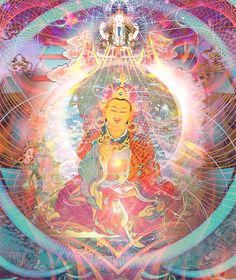Padmasambhava: Difference between revisions
(Created page with "thumb|Padmasambhava Padmasambhava (lit. "Lotus-Born"), also known as Guru Rinpoche, was an 8th-century Indian Buddhist master. Although there was a historic...") |
(→Termas) |
||
| Line 5: | Line 5: | ||
==Termas== | ==Termas== | ||
Padmasambhava also hid a number of religious treasures (termas) in lakes, caves, fields and forests of the Himalayan region to be found and interpreted by future tertöns or spiritual treasure-finders. | [[Padmasambhava]] also hid a number of religious treasures (termas) in lakes, caves, fields and forests of the Himalayan region to be found and interpreted by future tertöns or spiritual treasure-finders. According to Tibetan tradition, the Bardo Thodol (commonly referred to as the Tibetan Book of the Dead) was among these hidden treasures, subsequently discovered by a Tibetan terton, Karma Lingpa.<ref>[https://en.wikipedia.org/wiki/Padmasambhava Padma]</ref> | ||
==References== | ==References== | ||
Revision as of 19:37, 15 December 2016
Padmasambhava (lit. "Lotus-Born"), also known as Guru Rinpoche, was an 8th-century Indian Buddhist master. Although there was a historical Padmasambhava, nothing is known of him apart from helping the construction of the first Buddhist monastery in Tibet at Samye, at the behest of Trisong Detsen, and shortly thereafter leaving Tibet due to court intrigues.Padmasambhava introduced the people of Tibet to the practice of Tantric Buddhism. In Tibetan Buddhism, he is a character of a genre of literature called Terma, an emanation of Amitābha that is said to appear to tertöns in visionary encounters.
He is regarded as the founder of the Nyingma tradition. The Nyingma tradition is the oldest of the four major schools of Tibetan Buddhism.[note 5] The Nyingma tradition actually comprises several distinct lineages that all trace their origins to Padmasambhava. "Nyingma" literally means "ancient," and is often referred to as "Nga'gyur" "[note 6] or the "early translation school" because it is founded on the first translations of Buddhist scriptures from Sanskrit into Tibetan, in the eighth century. The group particularly believes in hidden terma treasures. Traditionally, Nyingmapa practice was advanced orally among a loose network of lay practitioners. Monasteries with celibate monks and nuns, along with the practice of reincarnated spiritual leaders are later adaptations, though Padmasambhava is regarded as the founder of Samye Gompa, the first monastery in the country. In modern times the Nyingma lineage has been centered in Kham in eastern Tibet.
Termas
Padmasambhava also hid a number of religious treasures (termas) in lakes, caves, fields and forests of the Himalayan region to be found and interpreted by future tertöns or spiritual treasure-finders. According to Tibetan tradition, the Bardo Thodol (commonly referred to as the Tibetan Book of the Dead) was among these hidden treasures, subsequently discovered by a Tibetan terton, Karma Lingpa.[1]


